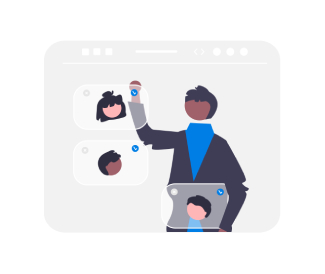What Is Peer Coaching in the Workplace?
Peer coaching is rapidly emerging as a powerful tool in employee development strategies. In an era where continuous learning and collaboration are essential to workplace success, organisations are increasingly turning to peer-to-peer coaching to encourage professional growth from within.
Unlike traditional top-down training methods, peer coaching at work enables employees to learn from each other through structured dialogue, observation, and shared experiences. It creates a learning culture that promotes feedback, trust, and accountability, leading to more engaged and capable teams.
Peer coaching refers to a structured, collaborative process where two or more colleagues at a similar professional level support each other's learning and development. Unlike managerial coaching, which is hierarchical, peer coaching fosters mutual learning relationships built on equality, empathy, and shared goals.
In the workplace, peer coaching typically involves:
- Setting development goals together
- Providing constructive feedback
- Sharing expertise, tools, and resources
- Reflecting on progress through regular check-ins
Peer coaching can be informal or part of a more formal peer coaching programme designed and managed by the HR department. When done effectively, it helps employees develop soft skills, improve task performance, and gain a deeper understanding of organisational dynamics.
Some examples of peer coaching in action include:
- A marketing executive coaching a peer on using data analytics tools
- Two team leaders exchanging leadership strategies and giving feedback
- Employees from different departments helping each other learn cross-functional processes
This approach reinforces collaborative learning while reducing the pressure or hierarchy associated with traditional coaching models.
How Does Peer Coaching Benefit Employee Development?
Peer coaching is more than just a learning activity; it is a culture-building tool that enhances trust, communication, and accountability within teams. Its benefits span personal development, team collaboration, and organisational performance.
1. Builds Trust and Collaboration
By engaging in peer-led conversations and problem-solving sessions, employees build meaningful relationships based on openness and trust. This lessens departmental silos and improves collaboration.
2. Encourages Continuous Learning
Unlike formal training programmes that may occur sporadically, peer coaching at work supports ongoing development. It turns the workplace into a learning environment where feedback is normalised.
3. Enhances Communication Skills
Peer coaching encourages active listening, clear articulation, and constructive feedback, all essential communication competencies in the modern workplace.
4. Supports Emotional Intelligence and Empathy
Coaching relationships require individuals to understand diverse perspectives, recognise others' challenges, and offer supportive responses, strengthening emotional intelligence.
5. Cost-Effective Training Alternative
When companies have budget constraints or limited access to external training resources, peer coaching training serves as a scalable and cost-efficient development method.
6. Accelerates Onboarding and Knowledge Transfer
New employees can benefit from peer coaching through faster integration, as their peers help them understand both the technical and cultural aspects of the organisation.
What's the Difference Between Peer Coaching and Mentoring?
While peer coaching and mentoring both contribute to learning and development, they differ significantly in structure, purpose, and dynamics.
| Aspect | Peer Coaching | Mentoring |
|---|---|---|
| Relationship | Colleagues at similar levels | Senior guides junior |
| Focus | Mutual development | Knowledge transfer |
| Duration | Short- or medium-term | Long-term and ongoing |
| Direction | Two-way coaching | Mostly one-way guidance |
| Structure | Often structured with goals and feedback loops | Can be informal or semi-structured' |
In essence, peer coaching is more collaborative and reciprocal, whereas mentoring is more hierarchical. Peer coaching encourages shared accountability for growth and creates a psychologically safe space for experimentation and honest reflection.
How Can HR Implement an Effective Peer Coaching Programme?
Designing and implementing a successful peer coaching programme requires a thoughtful blend of structure, training, and support systems. Here's a step-by-step guide HR teams can follow:
1. Define Objectives
Identify the purpose of launching peer coaching, whether it's leadership development, knowledge sharing, skill-building, or team alignment. This will shape how the programme is designed and evaluated.
2. Choose a Coaching Model
Decide whether peer coaching will be:
- One-on-One: Two employees paired based on common goals
- Group-Based: Small teams working together
- Project-Based: Coaching tied to specific deliverables or challenges
Choose a format that aligns with your organisation's size, culture, and learning goals.
3. Train Employees in Coaching Skills
Before launching, it's essential to provide peer coaching training to ensure participants know how to:
- Set coaching goals
- Ask powerful, open-ended questions
- Offer and receive feedback constructively
- Maintain confidentiality and trust
You can use internal HR trainers or bring in external facilitators for initial workshops.
4. Create Tools and Templates
Provide employees with structured peer coaching templates, goal sheets, session guides, and reflection forms. These tools help make the coaching sessions more productive and outcome-focused.
5. Assign Pairs or Groups Thoughtfully
Pair employees based on skill gaps, learning objectives, or shared projects. Avoid assigning individuals who may have unresolved conflicts or vastly different work styles.
6. Establish a Feedback Loop
Regularly check in with participants through surveys, one-on-one interviews, or debrief sessions. This helps HR understand what's working and what needs adjustment.
7. Recognise and Celebrate Progress
Acknowledge employees who actively participate and demonstrate improvement. Recognition reinforces a learning culture and encourages wider adoption.
Foster a culture of learning through peer coaching. Qandle's comprehensive HR suite enables structured peer coaching programmes, learning analytics, and performance insights all in one platform. Explore Qandle's Learning Solutions


 Back to Glossary
Back to Glossary